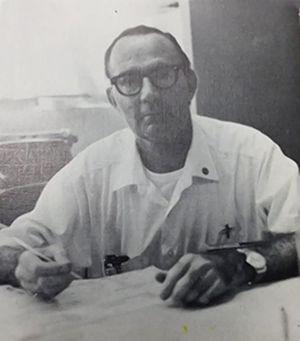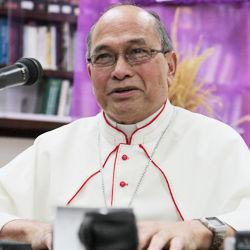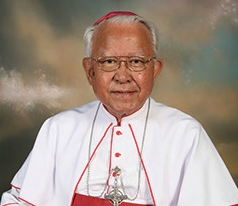|
$135M claims exceed church assets
By Neil Pang
With 30 individuals alleging child sex abuse at the hands of Guam Catholic priests spanning four decades, the total amount of monetary damages being sought in U.S. District Court of Guam cases now surpasses the amount of money the church currently holds in assets. Archdiocesan Finance Council President Richard Untalan recently said in a press conference with Guam's media that the council had identified about $132 million in net book assets, which include churches, land and schools under the Archdiocese of Agana. Of the 30 cases filed in local and federal courts, 27 were filed by plaintiffs represented by Attorney David Lujan. In those suits, the plaintiffs are pursuing "all general, special, exemplary and punitive damages, as allowed by law in a sum to be proven at trial and in an amount not less than ($5 million)." With 27 cases seeking at least $5 million each, the total amount sought by Lujan's clients has reached a minimum of $135 million. The statement made by the council earlier this month also unveiled the creation of a child sex abuse compensation fund for victims, which holds a minimum of $1 million in liquidated assets, in hopes the fund would help "ease the suffering of child sex abuse by the clergy." “The goal is to help them find peace,” Coadjutor Archbishop Michael Byrnes said. “Money alone won’t heal, but it can aid the healing process.” That fund, however, won't be available to claimants until after the group has identified a third-party entity to administer the fund, and with at least $135 million being fought for in court, the church may have to look elsewhere or pursue other financial recourse, such as filing for bankruptcy protection under the U.S. Bankruptcy Code. The issue of trust For the victims, such abuse at the hands of those ordained as priests represents the gravest violation of trust for those brought up to revere the sanctity of the Catholic Church and the priests who serve in its parishes. Michael Chargualaf, who has accused former Guam priest Rev. Louis Brouillard of abuse in the 1970s when he was 13 years old, stated he originally became an altar boy at the recommendation of his grandmother who raised him, and thought entering into altar boy service would help Chargualaf grow his Catholic faith. As he was preparing to serve with Brouillard for the first time, Chargualaf said he recalled sleeping at the back of the parish the night before to ensure he wouldn't be late to help prepare for 6 a.m. Sunday Mass. When that experience turned into the first of several instances of abuse, Chargualaf said he ran away from home, turned to drugs and alcohol and that the memories which he kept to himself impacted his relationships, and resulted in a constant battle with anger management and connecting with others, including his immediate family. Chargualaf said he didn't tell anyone about the incidents because he was scared, confused and worried his grandmother wouldn't believe him or that he'd be labeled a liar by others. "Back then the priest (was) infallible," he said. "Whatever they tell you to do, you do." Chargualaf's experience was not exclusive to his particular case – most, if not all, of the 30 cases contain statements from alleged victims that they dealt with their abuse by staying quiet, out of fear of being disrespectful or for going against their families' strongly held beliefs. For many, it was only after they witnessed other former altar boys coming forward that they felt they, too, could finally come forward about their own abuse. For the family of abuse victims, the knowledge that the abuse occurred under their own noses and, for many, as a result of their own consent to give priests continued access to their children, represents an oversight many won't soon forget. Take, for example, the case of Edith Doris Concepcion - the mother of alleged victim Joseph "Sonny" Quinata. According to court documents, Concepcion finally learned of the abuse as her son was going into surgery he would not survive. Before going into the operation room, Quinata finally told his mother about the abuse he suffered at the hands of then-Agat parish priest Anthony Apuron. Looking back at her son's childhood, Concepcion states in court documents that the many instances of her son's behavior finally made sense. During the time that Quinata was serving as an altar boy, he started to act out, including an attempt to stab Apuron and burn down the priest's house. For the Catholic faithful, the fact that such abuse may have been perpetrated for so long and affected so many young people entrusted to the care of those purported to represent, and spread the message of love and mercy clearly stated in Catholic scripture represents a comparable violation of trust if it can be shown that the church itself was aware of the abuse, and did little to stop it. Court documents state that Rev. Louis Brouillard, and other allegedly abusive priests, used their stature within the communities they served to obtain permission from the parents of their victims to have those children spend the night at their residences, "ostensibly to facilitate preparation for the following morning church services." "By presenting the overnight requests in this manner, priests routinely gained the approval of parents; often times the sexual abuses occurred during the night in their beds at the priests' residences," court documents state. In using the veneration of the church and of the role of altar service against the communities in which they served, court documents allege the church was able to "continually operate a veritable haren of young boys who were readily available to pedophiles who utilized the stature of the church into deceiving the community to regard them as high-level officials." Since the filing of the different lawsuits and the statements made by the accusers, church officials within the Archdiocese of Agana have conceded to the severity of the allegations and taken steps to address the issue. "With every person or persons who come forward to share accounts of being abused by clergy in the Catholic Church on Guam, each of us should grieve deeply,” Byrnes said. “Sexual abuse of children, no matter when or where it occurred, represents a betrayal of trust and harm of the worst kind; it has a devastating impact on the victim. Each of us in the church must see to it that the children entrusted to our care are stringently safeguarded from abuse or harm of any kind." Islandwide abuse With each successive case, the extent of the crimes allegedly committed in Guam's parishes by clergy becomes ever more evident and severe. Since the initial allegations made against Archbishop Apuron by Walter Denton, Roy Quintanilla, Roland Sondia and Concepcion, details of abuse of altar boys, and students at Catholic schools carried out on church grounds have spread out from Agat to include parishes and schools in Inarajan, Malojloj, Chalan Pago, Hagåtña, Mangilao, Barrigada, Sinajana and Mongmong. With the abuse spread out as much as has been alleged in the court documents, several accusers have made statements testifying to the lengths they took, often in vain, to avoid repeated contact with their alleged abusers. Given Guam's relatively small size and the nature of the island's close-knit village communities, victims of abuse would find it difficult to avoid all instances of contact with those who abused them. Accusers such as Leo Tudela and Anthony Flores state in their suits that their abuse extended beyond one singular location. Tudela's suit claims the Saipan resident first came to Guam and stayed at the St. Fidelis Friary in Sinajana where he endured sexual abuse by one of the friars identified in court documents only as Brother Mariano. Later, Tudela said he met Brouillard who asked him to serve as an altar boy at Santa Teresita Catholic Church in Mangilao where he was then abused by Brouillard. Flores' suit states the San Roke Parish altar boy was also abused at San Vicente Catholic School in Barrigada where he was enrolled as a student. In both locales, Flores stated in his lawsuit that Brouillard, who served as a priest at the church and a counselor at the school, fondled and otherwise abused him. For the original four accusers who named Apuron as their abuser, and for Melvin Duenas, the abuse was particularly egregious because it was committed by individuals who would rise up in the ranks of the archdiocese. In the case of Denton, Quintanilla and Sondia, the three grew up witnessing the former Agat priest rise in the ranks to be finally installed as the archbishop of Hagåtña. Likewise for Duenas, his alleged abuser, Tomas Camacho, would rise from Inarajan Parish priest to bishop of the Commonwealth of the Northern Mariana Islands. For many, the fact that such accusations have been made agsint some of the highest officials within the archdiocese is proof enough to suggest culpability on the part of the Archdiocese of Agana. Will the church survive? As the church enters into this brave new world, many, including Byrnes, are preparing for every possible outcome – be it a settlement, bankruptcy court protection, or another way. However, even with the threat of potential bankruptcy court protection on the horizon, Guam's Catholic faithful remain believers of their faith. While the so far 30 accusers have each recounted terrible abuse at the hands of the most trusted within the community, each also testified that his faith remains unchanged. They see the abuse they endured as being committed by individual men who fell from grace, and not as a product of the Catholic faith itself. The Archdiocese of Agana has taken steps toward healing the wounds of the past and addressing the concerns of the future. Under Byrnes' leadership, the church has not only established a settlement fund for abuse victims, but it has also carried out, and continues to carry out, an extensive educational program to inform all those who work with children under the umbrella of the archdiocese, of protocol changes enacted by the adoption of the Charter for the Protection of Children and Young People. While the conclusion of these 30 or more lawsuits may see the church lose almost every material asset it has, Guam's Catholic faithful are confident the body that rises from the ashes will be all the stronger for having purged itself of this cancer. Contact: neil@postguam.com
|
.
Any original material on these pages is copyright © BishopAccountability.org 2004. Reproduce freely with attribution.


